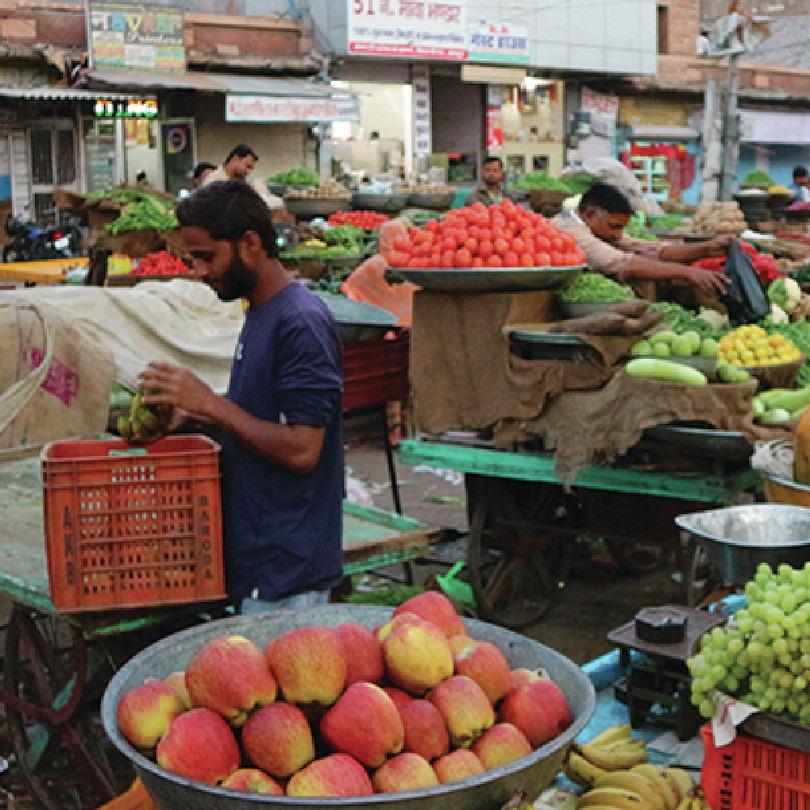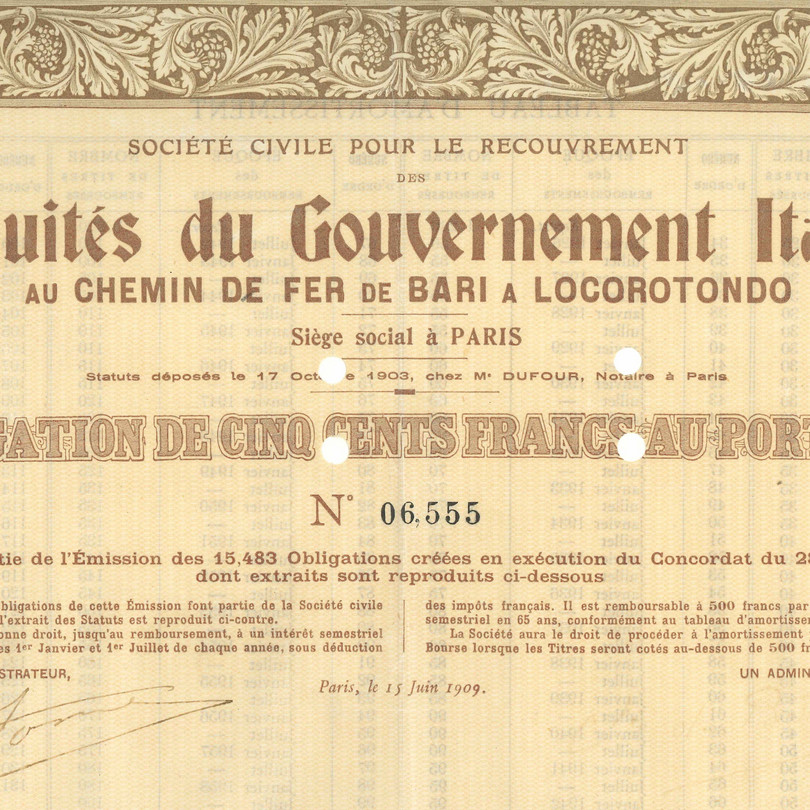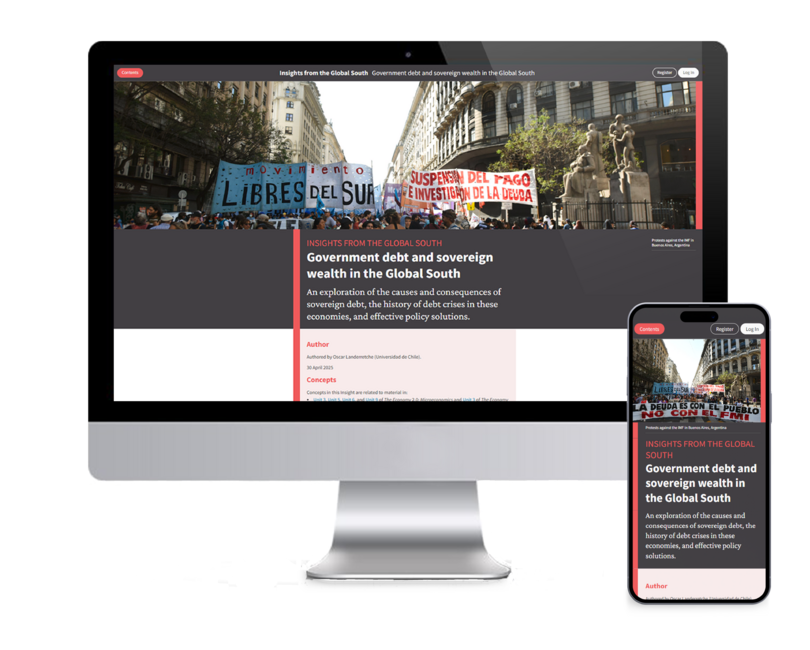Interactive questions
Check your understanding with instant feedback and extra guidance.
Interactive charts
Analyse the story behind the data with interactive charts.
Exercises
Student exercises on selected topics treated in CORE Insights.
Suggestions for further research
Selected literature on topics treated in these Insights.
Insights from the Global South are a collection of self-contained educational resources that illuminate critical issues facing low and middle income countries, with a focus on a specific set of policy concerns. While some of the policy issues relate to structural and policy challenges as economies move to higher levels of per capital income, others relate to the impact of global crises.

Government debt and sovereign wealth in the Global South
Lower- and middle-income economies often rely on foreign debt to invest in key areas like infrastructure and public health. This Insight explores the causes and consequences of sovereign debt, the history of debt crises in these economies, and effective policy solutions.
Authored by Oscar Landerretche (Universidad de Chile)

The sky’s the limit: The economics of inflation and hyperinflation
Money is essential to a market economy, serving as a store of value, a unit of account, and a means of exchange. All of these functions are compromised by high inflation. This Insight explores the multiple mechanisms that underlie inflation, from low to extremely high levels, and discusses policy solutions.
Authored by Paul Segal (IAE Business School, Universidad Austral, Argentina)

Public health and development: Infrastructure, social norms and health behaviours
This Insight uses economics to help explain the persistence of poor public health and explores the role of government spending and other ways to achieve better health outcomes in low-income countries.
Authored by Maria Laura Alzua (CEDLAS, Universidad Nacional de La Plata and Partnership for Economic Policy (PEP), Kenya)

Informality and the capitalist economy
Low- and middle-income countries have a dual economy, with both a capitalist sector and an informal sector. This Insight uses the dual economy model by Arthur Lewis to explain how structural change occurs, and the role of economic policies and civil society efforts in promoting this transition.
Authored by Amit Basole (Azim Premji University) and Rosa Abraham (Azim Premji University)

Coming soon
How public, private, and community responses can reduce the risk of poverty
Vulnerability to poverty is the risk that a household or individual may fall below the poverty line due to unexpected events. This Insight explores the factors that affect the risk and discusses poverty mitigation mechanisms.
Authored by Andrés Álvarez (Universidad de Los Andes), Juan Camilo Cárdenas (Universidad de Los Andes and University of Massachusetts Amherst), Jeanna A. Martínez (Universidad de Los Andes), and Paula A. Remicio (Universidad de Los Andes)

Coming soon
Climate injustice

Persistent racial inequality in the United States
Racial inequality has been an enduring feature of the American economy throughout its history. Focusing primarily on the inequality between Black and White Americans, this CORE Insight explores the mechanisms which have caused and perpetuated that inequality, and what might be required to end it.
Authored by Eric Bottorff (Oakton Community College, US), Trevon Logan (The Ohio State University), and Suresh Naidu (Columbia University).

Public debt: threat or opportunity?
An introduction to the historical origins and economic analysis of public debt. This Insight helps students to understand the connections between debt and deficits, analyse debt sustainability, and consider the economic and political challenges of public debt management.
Authored by Barry Eichengreen (University of California, Berkeley) and Ugo Panizza (Geneva Graduate Institute, Switzerland).

A world of differences: an introduction to inequality
Our prospects in life are shaped by a combination of personal characteristics and the environments in which we find ourselves. Both characteristics and conditions faced vary widely across individuals and groups. Read this Insight to learn about the meaning, measurement, and implications of economic inequality.
Authored by Suresh Naidu (Columbia University), Rajiv Sethi (Barnard College, Columbia University and Santa Fe Institute, US), and Sarah Thomas (Barnard College, Columbia University).

Too big to fail: lessons from a decade of financial sector reforms
This CORE Insight looks at what happened during the global financial crisis and how regulatory reforms since then aim to address the problems that arise when banks become too big to be allowed to fail.
Authored by Claudia M. Buch (Deutsche Bundesbank), Angelica Dominguez-Cardoza (Deutsche Bundesbank and University of Kiel, Germany), and Jonathan Ward (Financial Stability Board).

Financing American government
This CORE Insight explains how the US Department of Treasury finances government spending and how the US Federal Reserve System conducts monetary policy both during times of normalcy and during economic crises.
Authored by Martina Jasova (Barnard College, Columbia University) and Rajiv Sethi (Barnard College, Columbia University and Santa Fe Institute, US).
Extra resources
Lecture slides
Customizable Powerpoint slides.
Exercise answers
Coming soon—a set of model answers to all the exercises from the Insights.
PDF downloads
As they are released, Insights are made available for download in PDF.



